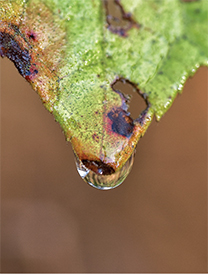 Human nature is what it is! When something is right, we like to take credit for it; when something is wrong, we rarely accept the fact that the problem could have something to do with us.
Human nature is what it is! When something is right, we like to take credit for it; when something is wrong, we rarely accept the fact that the problem could have something to do with us.
I was photographing a dew drop at the end of a leaf. I setup my camera on my trusty Gitzo tripod, manually focussed my macro lens for maximum sharpness, ensured that the image appeared sharp in the viewfinder, carefully set the exposure (which was 1/60 sec at f/16 at ISO 800) and took the shot. Took a few more shots as insurance against unknown and unforeseen problems. I then enlarged the images on the camera’s LCD to check for sharpness. I was a bit disappointed. The images were acceptably sharp but not as sharp as I would have liked them to be. I re-checked the focus and took few more shots. Same results. Images were not to my personal standard of sharpness.
What could be the problem? I had used the same lens a few days before and hence that was unlikely to be them problem. I had used the same camera body before, so that was also unlikely to be the problem. Could the leaf and the dew drop be moving during exposure? No; as far as I could see, the subject was steady. There was no strong breeze either.
Determined to get to the bottom of this mystery, I viewed the dewdop again, this time through Live View. I enlarged the view and to my horror, saw the leaf and the dew drop continuously shaking in the almostno- breeze situation! Even at this moment, with my naked eyes, I could see no subject movement; and yet, it was continuously shaking!
Mystery solved! Lesson learned!
Whenever possible, especially when doing macro photography:
1. Use Live View (camera on a firm tripod) if your camera permits it.
2. Enlarge the image on the LCD and carefully focus the subject using manual focus.
3. Use as fast a shutter speed as possible for the given lighting condition and the aperture used.
4. Remember that the depth of field, even with a narrow aperture like f/11 or f/16, is not likely to be enough to keep the entire subject sharp. Focus sharply on the eyes if it is a live subject. If not, focus critically at the spot that you want to be the sharpest.
5. We all like to
do macro photography at life-size (1:1), but is is better to photograph at half-life-size (1:2) and then enlarge the image in post-processing. This should get you better depth of field.
6. For maximum safety, use mirror lock up (if that is possible) and trip the shutter using a wireless remote or using the self-timer.
Note: For a ‘live’ subject, using the self-timer may not be the ideal method since the subject could move during the set time.

